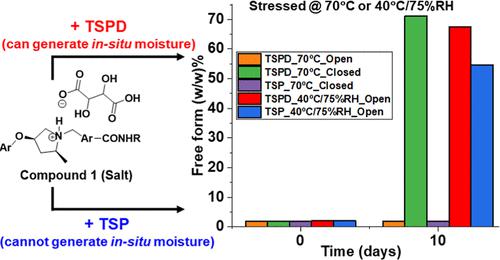当前位置:
X-MOL 学术
›
Mol. Pharmaceutics
›
论文详情
Our official English website, www.x-mol.net, welcomes your
feedback! (Note: you will need to create a separate account there.)
The Effect of In-Situ-Generated Moisture on Disproportionation of Pharmaceutical Salt
Molecular Pharmaceutics ( IF 4.5 ) Pub Date : 2022-12-16 , DOI: 10.1021/acs.molpharmaceut.2c00765 Asmerom O Weldeab 1 , John-David McElderry 2 , Yiqing Lin 1
Molecular Pharmaceutics ( IF 4.5 ) Pub Date : 2022-12-16 , DOI: 10.1021/acs.molpharmaceut.2c00765 Asmerom O Weldeab 1 , John-David McElderry 2 , Yiqing Lin 1
Affiliation

|
Pharmaceutical salts are ubiquitously present in the market given their benefits in optimizing the critical properties of an active pharmaceutical ingredient (API). Achieving these benefits requires careful selection and understanding of the salt form of choice. Stability is especially critical here, as salts are susceptible to disproportionation. Several studies have shown the impact of moisture on disproportionation, with more focus on external humidity (moisture coming from outside the system). This work, on the other hand, is systematically designed to study the impact of moisture generated in situ (moisture produced within the system). To that end, an in-house developed compound 1 was selected as our salt API, and its disproportionation was studied in blends (binary and prototype) with hydrated model excipient─trisodium phosphate dodecahydrate (TSPD). TSPD possesses 12 water molecules, which could get released when triggered with enough energy (confirmed by thermogravimetric analysis and humidity studies). As a control for this study, similar blends were prepared with anhydrous trisodium phosphate (TSP), which has comparable properties to TSPD but lacks water. Overall, significant disproportionation was observed in TSPD blends exposed to 40 °C or 70 °C in a closed system; while no disproportionation was observed when the system was left open due to the escape of the moisture generated in situ. The API also remained intact for the blends with anhydrous TSP, as expected. Meanwhile, stressing at 40 °C/75%RH condition resulted in significant disproportionation for both TSPD and TSP blends due to the exposure to external humidity. Hydrated excipients are normally used in drug development, and this work stresses the need for probing the impact from within the system when such excipients are utilized with salt API. This will help fully unravel the overall effect of moisture on the drug, which is relevant downstream when selecting processing conditions, packaging, and so forth.
中文翻译:

原位产生的水分对药用盐歧化的影响
药用盐在优化活性药物成分 (API) 的关键特性方面具有优势,因此在市场上随处可见。实现这些好处需要仔细选择和理解所选择的盐形式。稳定性在这里尤为重要,因为盐很容易发生歧化。几项研究表明水分对歧化的影响,更侧重于外部湿度(来自系统外部的水分)。另一方面,这项工作是系统地设计用于研究原位产生的水分(系统内产生的水分)的影响。为此,内部开发的化合物1被选为我们的盐 API,并在与水合模型赋形剂─十二水磷酸三钠 (TSPD) 的混合物(二元和原型)中研究了它的歧化作用。TSPD 拥有 12 个水分子,当被足够的能量触发时会释放出来(通过热重分析和湿度研究证实)。作为本研究的对照,使用无水磷酸三钠 (TSP) 制备了类似的混合物,无水磷酸三钠 (TSP) 具有与 TSPD 相当的特性,但缺少水。总体而言,在封闭系统中暴露于 40 °C 或 70 °C 的 TSPD 混合物中观察到显着的歧化;而由于原位产生的水分逸出,当系统保持打开状态时没有观察到歧化。正如预期的那样,对于含有无水 TSP 的混合物,API 也保持完整。同时,由于暴露在外部湿度下,在 40 °C/75%RH 条件下施加应力导致 TSPD 和 TSP 混合物显着歧化。水合赋形剂通常用于药物开发,这项工作强调需要探索当此类赋形剂与盐 API 一起使用时来自系统内部的影响。这将有助于充分揭示水分对药物的整体影响,这与下游在选择加工条件、包装等方面相关。
更新日期:2022-12-16
中文翻译:

原位产生的水分对药用盐歧化的影响
药用盐在优化活性药物成分 (API) 的关键特性方面具有优势,因此在市场上随处可见。实现这些好处需要仔细选择和理解所选择的盐形式。稳定性在这里尤为重要,因为盐很容易发生歧化。几项研究表明水分对歧化的影响,更侧重于外部湿度(来自系统外部的水分)。另一方面,这项工作是系统地设计用于研究原位产生的水分(系统内产生的水分)的影响。为此,内部开发的化合物1被选为我们的盐 API,并在与水合模型赋形剂─十二水磷酸三钠 (TSPD) 的混合物(二元和原型)中研究了它的歧化作用。TSPD 拥有 12 个水分子,当被足够的能量触发时会释放出来(通过热重分析和湿度研究证实)。作为本研究的对照,使用无水磷酸三钠 (TSP) 制备了类似的混合物,无水磷酸三钠 (TSP) 具有与 TSPD 相当的特性,但缺少水。总体而言,在封闭系统中暴露于 40 °C 或 70 °C 的 TSPD 混合物中观察到显着的歧化;而由于原位产生的水分逸出,当系统保持打开状态时没有观察到歧化。正如预期的那样,对于含有无水 TSP 的混合物,API 也保持完整。同时,由于暴露在外部湿度下,在 40 °C/75%RH 条件下施加应力导致 TSPD 和 TSP 混合物显着歧化。水合赋形剂通常用于药物开发,这项工作强调需要探索当此类赋形剂与盐 API 一起使用时来自系统内部的影响。这将有助于充分揭示水分对药物的整体影响,这与下游在选择加工条件、包装等方面相关。















































 京公网安备 11010802027423号
京公网安备 11010802027423号